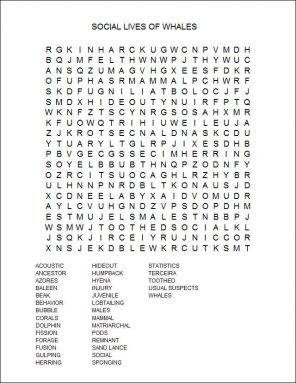The social lives of whales
Scientists are beginning to understand the complex interactions among dolphins and other cetaceans
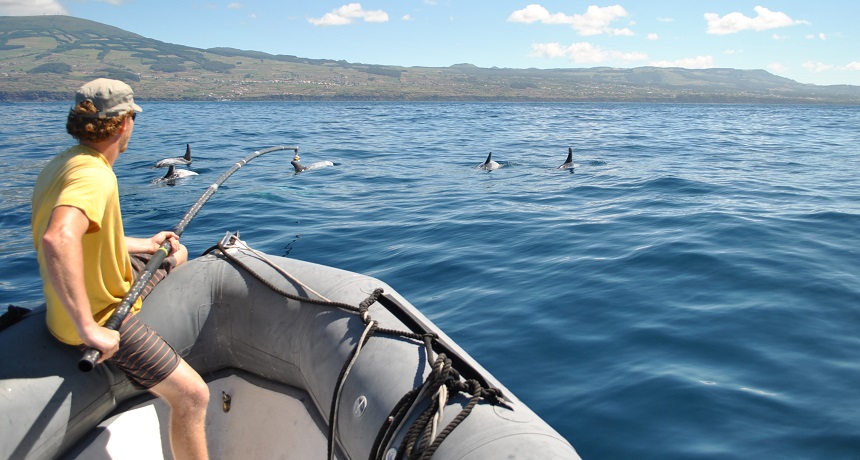
Dutch biologist Machiel Oudejans attempts to apply an acoustic tag onto the back of a Risso’s dolphin off the coast of Terceira Island, Portugal.
E. Wagner
By Eric Wagner
TERCEIRA ISLAND in Portugal’s Azores — The Usual Suspects are at it again. From the small Zodiac, I can see them coming towards us. Their gray dorsal fins slice through the water just off the coast of Terceira, an island in the middle of the Atlantic Ocean.
Fleur Visser, a Dutch biologist, can see them, too. She angles the small, inflatable speedboat towards the fins. This group of dolphins always appear to move as a group. That’s how they’ve come to be nicknamed the Usual Suspects.
Machiel Oudejans is a biologist with Kelp Marine Research in the Netherlands. From the front of our boat, he rushes to put together a pole that is nearly six meters (20 feet) long. Afterward, he braces himself against the side of the boat, one leg dangling over the side. The pole sticks far out over the water. “Okay, they’re almost right in front of us!” he calls to Visser.
At the end of his pole is an acoustic tag about the size and color of a mango. Once attached to a dolphin, it will record how fast the animal swims, how deeply it dives, the sounds it makes and the sounds it might hear. Visser is trying to get close enough so that Oudejans can reach out and stick the tag’s suction cups onto the back of one the Usual Suspects. But the animals are not cooperating.
Visser slows the boat. It purrs through the calm sea. We sidle up behind the Usual Suspects. These six dolphins are swimming side by side, some only a meter or two (three to six feet) apart. They surface to breathe at almost exactly the same time. The ocean is so clear that their bodies glow white underwater. They may be puttering along now, but they seem to know how to stay just out of Oudejans’ reach. And if Visser were to speed up, the growl of the boat’s engine might spook them, prompting them to vanish.
The Usual Suspects are a type of whale known as Risso’s dolphins. At 3 to 4 meters (10 to 13 feet) long, they are medium-sized, as whales go. (Porpoises, dolphins and other whales all make up a group of marine mammals called cetaceans. See Explainer: What is a whale? ) Although the Risso’s dolphin lacks a dolphin’s typical beak, it has kept its odd half-smile.The species’ scientific name — Grampus griseus — means “fat gray fish.” But Risso’s dolphins are neither fish nor gray. Instead, by the time they become adults, they will be covered with so many scars that they appear almost white. Those scars serve as badges from run-ins with other Risso’s dolphins. No one knows exactly why, but often they’ll rake their sharp teeth over a neighbor’s skin.
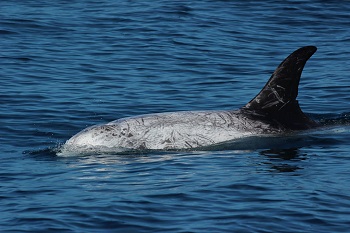
All over the world, new tools and statistical techniques are letting scientists study the behaviors of cetaceans more closely than ever before. The data they gather are upending long-held assumptions. As Visser is learning with Risso’s dolphins, there is much more to whale social lives than meets the eye.
Unusual social groups
One reason scientists had not studied Risso’s much had to do with the animals’ haunts. Since these dolphins feed mostly on squid, they favor deep water. Risso’s can dive several hundred meters in pursuit of squid. And they can stay underwater for more than 15 minutes at a time. There are only a few places in the world where water that deep is within easy reach of shore. Terceira Island is one of them. And that’s why Visser has chosen to work here. It’s the perfect Risso’s laboratory, she explains.
Terceira is an island in the Azores archipelago. This Atlantic island chain lies roughly halfway between Portugal and the United States. The lush remnants of extinct volcanoes, these islands are geologically quite young. The oldest is roughly 2 million years old. Its youngest sibling is an island that rose out of the sea only about 800,000 years ago. What makes these islands so good for Visser’s team is that their sides are quite steep. The deep water that Risso’s favor is only a few kilometers from shore — an easy reach even from Visser’s small boat.
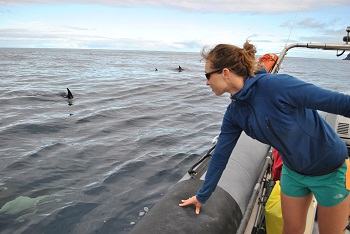
But the more she watched these animals, the more she began to suspect that she was witnessing behaviors no one had ever reported in cetaceans.
There are two types of whales: those with teeth, and those that filter food from the water using plates in their mouths called baleen (bay-LEEN). (Baleen is made up of keratin, just like your fingernails.) Baleen whales largely keep to themselves. Toothed whales instead tend to travel in groups called pods. They may do this to find food, to secure mates or to help guard against predators.
Biologists had thought the social interactions of toothed whales fell into only two types. The first are called fission-fusion societies. The second are matriarchal (MAY-tree-ARK-ul) pods — groups led by the mother or grandmother of many of its members. There is a rough relationship between the size of a toothed whale and the type of society it forms. Smaller whales tend to exhibit fission-fusion societies. Larger whales mostly form matriarchal pods.
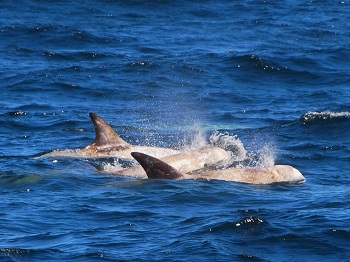
Matriarchal pods, in contrast, are far more stable. These groups organize around one or two older females, with several generations of female relatives, their unrelated mates and their offspring. Some pods contain up to 50 animals. Female offspring spend their entire lives in their family’s pod; males usually go off on their own once they mature. (In some species, if the males find a mate, they may join the female’s pod.)
Pod identities can be both strong and unique. Different groups of killer whales and sperm whales, for instance, have their own sets of clicks, whistles and squeaks that they use to communicate with one another. Different pods might also hunt for different prey, even when they roam the same waters.
But with Risso’s dolphins, Visser saw something of a mix of the two social styles. As with a fission-fusion society, the dolphins could join to form immense groups, with hundreds of individuals. Such parties did not last long. But Visser also found some individuals that traveled together for years, as in a matriarchal pod. Yet these weren’t matriarchal pods, she noted; the group members were not related. Instead, the groups were clearly dividing themselves up by sex and age. Males stayed with males, and females with females. Adults teamed up with other adults, and juveniles with juveniles.
Especially surprising: Groups of old males, such as the Usual Suspects, hung out together. In most marine mammals, old males are solitary. Until now, Visser says, “nobody had ever documented anything like that.”
Cetacean teachers
A species’ social structure strongly influences how it behaves. Risso’s dolphins, Visser says, can have best friends, other chums and, maybe, somewhat distant acquaintances. Together, these relationships describe the animals’ “social network,” Visser explains. Her work is part of a growing effort by scientists to use sophisticated tools and statistics — mathematical tools — to learn the subtle skills that whales teach each other.
At Shark Bay off of the west coast of Australia, a team of scientists from Australia and Europe has been studying a population of bottlenose dolphins for more than 30 years. A few years back, the researchers noticed that some dolphins wrapped their beaks with basket sponges before they went hunting for nutritious fish near the seafloor. This “sponging,” as the scientists called it, allowed the animals to forage among sharp rocks and corals, without risking injury. Those sponges protected the dolphins’ beaks as they rousted fish from their hideouts.
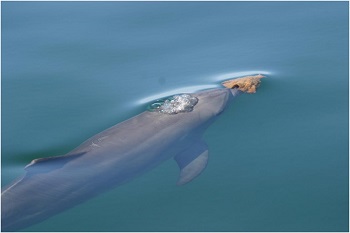
Not all bottlenose dolphins in Shark Bay use sponges this way. But those that do tend to be related to each other. A genetic analysis, published in 2005 in Proceedings of the National Academy of Sciences, traced the practice back almost 180 years to a single female ancestor. But more important than their being related is how dolphins pick up the skill: They are taught. Females appear to act as instructors, teaching the skill to their daughters — and occasionally to their sons.
Another group of biologists, led by Janet Mann from Georgetown University, in Washington, D.C., confirmed the importance of teaching. To do it, they borrowed a technique used to study social networks in people. Sponging dolphins are more likely to form groups with other sponging dolphins than they are to hang out with non-spongers. In 2012, the team published its finding in Nature Communications.
Sponging, Mann and her co-authors now conclude, is very much like a human subculture. They liken it to skateboarders who prefer to hang out with other skateboarders.
Watching a new trick take hold
Even baleen whales, long thought to be relatively solitary, will teach each other new skills, scientists are finding.
Humpbacks, a type of baleen whales, often engage in a practice known as “bubble-netting.” The animals swim below schools of fish and then blow clouds of bubbles. These bubbles panic the fish, which prompts them to cluster into a tight ball. The whales then swim right through the ball with their mouths open, gulping fish-filled water.
In 1980, whale watchers saw a single humpback off of the East Coast of the United States do a modified version of this behavior. Before it blew bubbles, the animal slapped the water with its tail. That slapping behavior is known as lobtailing. For the next eight years, observers watched as more and more humpbacks picked up the practice. By 1989, nearly half of the population lobtailed the water before starting to bubble-net a dinner.
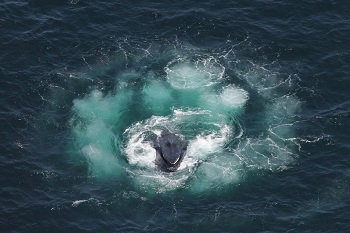
Still, what made this new lobtailing trick spread so rapidly through the Eastern humpbacks? Did the whale’s sex matter, as with the spongers? Did a calf learn lobtailing from its mother? No. The best predictor of whether a humpback would lobtail before bubble-netting was if it had watched another humpback do it.
“The animals were simply learning from individuals they had spent a lot of time with,” explains Rendell. It was the first time anyone had documented a spread of such a behavior through an animal’s social network, he notes. His team described its findings in a paper in Science in 2013.
A BUBBLE NET Humpback whales blow bubbles to herd fish into an edible formation. BBC Earth |
Recognizing such changes in a whale’s behavior, Rendell argues, was possible only because people have been gathering data on this species for decades. Now that statistical tools are capable of analyzing such data in ways that are more clever than ever before, patterns are beginning to emerge that earlier escaped notice. And, he adds: “I think we will see a lot more of these sorts of insights in the next few years.”
Visser has been amassing such data on the Risso’s dolphins in the Azores. She plans to continue recording their complex behaviors, watching how their unique social structure influences the ways they interact — or don’t. For instance, she plans to begin probing what clues a Risso’s behavior at the surface might offer about what is going on underwater.
“We are really only at the beginning of understanding what makes them decide to do what they do,” she says, “or how they know what the others are thinking.”
Power Words
(for more about Power Words, click here)
acoustics The science related to sounds and hearing.
archipelago A group of islands, many times forming in an arc across a broad expanse of the oceans. The Hawaiian islands, the Aleutian islands and the more than 300 islands in the Republic of Fiji are good examples.
baleen A long plate made of keratin (the same material as your fingernails or hair). Baleen whales have many plates of baleen in their mouths instead of teeth. To feed, a baleen whale swims with its mouth open, collecting plankton-filled water. Then it pushes water out with its enormous tongue. Plankton in the water become trapped in the baleen, and the whale then swallows the tiny floating animals.
bottlenose dolphin A common species of dolphin (Tursiops truncate), which belongs to the order Cetacea among marine mammals. These dolphins are found all over the world.
bubble-netting A method of corralling food in the ocean practiced by humpback whales. blow a lot of bubbles as they swim in a circle underneath schools of fish. This frightens the fish, causing them to bunch tightly in the center. To collect the fish, one humpback after another swims through the tightly bunched school of fish with its mouth open.
cetaceans The order of marine mammals that includes porpoises, dolphins and other whales and. Baleen whales (Mysticetes) filter their food from the water with big baleen plates. The remaining cetaceans (Odontoceti) include some 70 species of toothed animals that include beluga whales, narwhals, killer whales (a type of dolphin) and porpoises.
dolphins A highly intelligent group of marine mammals that belong to the toothed-whale family. Members of this group include orcas (killer whales), pilot whales and bottlenose dolphins.
fission The spontaneous splitting of a large unit into smaller self-sustaining parts.
fission-fusion society A social structure seen in some whales, usually in dolphins( such as bottlenose or common dolphins). In a fission-fusion society, individuals do not form long-term bonds. Instead, they come together (fuse) in large, temporary groups that may contain hundreds — sometimes thousands — of individuals. Later, they will split (fission) into small groups and go their separate ways.
fusion The merging of two things to form a new combined entity.
genetic Having to do with chromosomes, DNA and the genes contained within DNA. The field of science dealing with these biological instructions is known as genetics. People who work in this field are geneticists.
gunwale The upper edge of the side of a boat or ship.
herring A class of small schooling fish. There are three species. They are important as food for humans and whales.
humpback A species of baleen whale (Megaptera novaeangliae), perhaps best known for its novel “songs” that travel great distances underwater. Huge animals, they can grow up to more than 15 meters (or around 50 feet) long and weigh more than 35 metric tons.
killer whale A dolphin species (Orcinus orca) belonging to the order Cetacea (or cetaceans) of marine mammals.
lobtail A verb that describesa whale slapping its tail against the surface of the water.
mammal A warm-blooded animal distinguished by the possession of hair or fur, the secretion of milk by females for feeding the young, and (typically) the bearing of live young.
marine Having to do with the ocean world or environment.
matriarchal pod A group of whales organized around one or two older females. The pod may contain up to 50 animals, including female relatives of the matriarch (or female leader), and their offspring.
pod (in zoology) The name given to a group of toothed whales that travel together, most of them throughout their life, as a group.
sand lance A small, schooling fish that is important food for many species, including whales and salmon.
social network Communities of people (or animals) that are interrelated owing to the way they relate to each other.
sponge A primitive aquatic organism with a soft porous body.
Word Find (click here to enlarge for printing)
